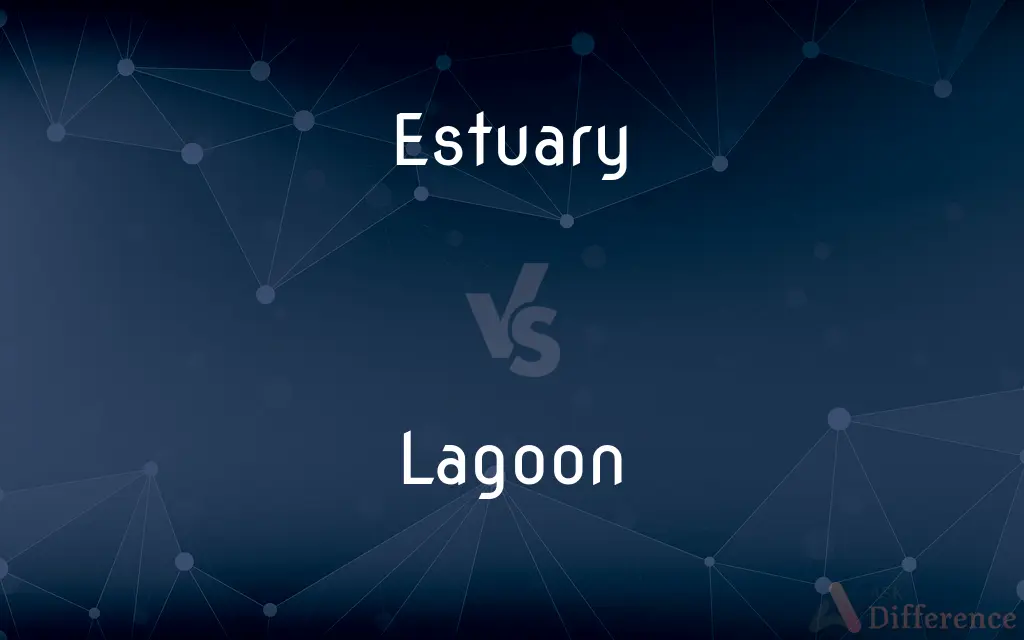Estuary vs. Lagoon — What's the Difference?
By Tayyaba Rehman — Published on January 26, 2024
An estuary is a partially enclosed coastal body of water where freshwater from rivers mixes with seawater. A lagoon is a shallow body of water separated from the ocean by sandbars, barrier islands, or coral reefs.

Difference Between Estuary and Lagoon
Table of Contents
ADVERTISEMENT
Key Differences
Estuary: Estuaries are dynamic environments where rivers meet the sea, creating a mix of fresh and saltwater. Lagoon: Lagoons are typically separated from the ocean by a natural barrier, leading to more stable and calm waters.
Estuary: These areas are characterized by their brackish water, which is a mix of fresh and saltwater, supporting diverse ecosystems. Lagoon: Lagoons often have higher salinity than the open sea, especially if their connection to the ocean is limited.
Estuary: Estuaries serve as important habitats for various wildlife, offering breeding and feeding grounds. Lagoon: Lagoons provide a protected environment, often serving as nurseries for fish and bird species.
Estuary: The water flow and salinity in estuaries can change dramatically due to tides, rainfall, and river flow. Lagoon: In lagoons, water exchange with the ocean is more restricted, leading to less fluctuation in salinity and water levels.
Estuary: Estuaries often serve as crucial economic zones, supporting activities like fishing, shipping, and tourism. Lagoon: Lagoons are popular for recreational activities like swimming, boating, and bird-watching, due to their calm waters.
ADVERTISEMENT
Comparison Chart
Water Composition
Mix of freshwater and seawater (brackish)
Typically saltwater, occasionally brackish
Barrier to Ocean
Open to ocean, no physical barrier
Separated by sandbars, barrier islands, or reefs
Biodiversity
High, diverse ecosystems
Often serve as nurseries for marine life
Water Fluctuation
Subject to tides and river flow
More stable, restricted ocean exchange
Human Use
Supports fishing, shipping, tourism
Popular for recreational activities
Compare with Definitions
Estuary
An estuary is a coastal area where freshwater from rivers mixes with seawater.
The estuary is home to numerous bird species due to its rich biodiversity.
Lagoon
Some lagoons are known for their high salinity, creating unique ecosystems.
The high salinity of the lagoon makes it an ideal habitat for certain bird species.
Estuary
Estuaries are characterized by their brackish water.
Fishing in the estuary can be rewarding due to the variety of fish species.
Lagoon
Lagoons are often found along coastal areas, behind barrier islands or reefs.
We kayaked through the calm waters of the coastal lagoon.
Estuary
Estuaries are crucial for the lifecycle of many marine and bird species.
The estuary serves as a breeding ground for several migratory bird species.
Lagoon
A lagoon is a shallow body of water separated from the ocean by a barrier.
The lagoon's crystal-clear waters are perfect for snorkeling.
Estuary
Estuaries often act as natural buffers, protecting inland areas from sea surges.
The estuary helped mitigate the impact of the storm surge on the coastline.
Lagoon
Many lagoons are vital for local wildlife, serving as nurseries for fish and birds.
The lagoon is bustling with juvenile fish, indicating its importance as a nursery habitat.
Estuary
Many estuaries are important commercial and recreational areas.
We enjoyed a boat tour in the estuary, observing its unique ecosystem.
Lagoon
Lagoons often provide tranquil environments for recreational activities like swimming and boating.
The serene lagoon was our favorite spot for a peaceful afternoon swim.
Estuary
The part of the wide lower course of a river where its current is met by the tides.
Lagoon
A shallow body of water, especially one separated from a sea by sandbars or coral reefs.
Estuary
An arm of the sea that extends inland to meet the mouth of a river.
Lagoon
A shallow artificial pond used for treating or storing liquid waste material or for collecting flood waters.
Estuary
A coastal water body where ocean tides and river water merge, resulting in a brackish water zone.
Lagoon
A shallow body of water separated from deeper sea by a bar.
Estuary
An ocean inlet also fed by fresh river water.
Lagoon
A shallow sound, channel, pond, or lake, especially one into which the sea flows; as, the lagoons of Venice.
Estuary
A place where water boils up; a spring that wells forth.
Lagoon
A lake in a coral island, often occupying a large portion of its area, and usually communicating with the sea. See Atoll.
Estuary
A passage, as the mouth of a river or lake, where the tide meets the current; an arm of the sea; a frith.
It to the sea was often by long and wide estuaries.
Lagoon
A body of water cut off from a larger body by a reef of sand or coral
Estuary
Belonging to, or formed in, an estuary; as, estuary strata.
Estuary
The wide part of a river where it nears the sea; fresh and salt water mix
Common Curiosities
What role do estuaries play in the environment?
Estuaries play a crucial role in the environment as habitats for wildlife, natural buffers against storms, and as nurseries for marine species.
How is a lagoon formed?
A lagoon is formed when shallow waters are separated from the ocean by sandbars, barrier islands, or coral reefs.
What defines an estuary?
An estuary is defined as a partially enclosed coastal body of water where freshwater mixes with seawater.
Are estuaries important for bird migration?
Yes, many estuaries are important stopover points for migratory birds.
Can lagoons be artificially created?
Yes, lagoons can be artificially created for various purposes, including recreation and wastewater treatment.
What type of water is found in estuaries?
Estuaries contain brackish water, a mix of freshwater and seawater.
Do estuaries experience tidal influences?
Yes, estuaries are influenced by tides, leading to changes in water flow and salinity.
How do lagoons affect local climates?
Lagoons can affect local climates by moderating temperatures and influencing local weather patterns.
Are lagoons typically saltwater or freshwater?
Lagoons are typically saltwater but can occasionally be brackish.
Can lagoons support diverse ecosystems?
Yes, lagoons can support diverse ecosystems, often serving as nurseries for various marine life.
What activities are popular in lagoons?
Lagoons are popular for activities like swimming, boating, and bird-watching.
Are estuaries used for commercial purposes?
Yes, estuaries are often used for commercial purposes like fishing, shipping, and tourism due to their rich resources and strategic locations.
Is the water in lagoons usually clear or murky?
The clarity of water in lagoons can vary, but many lagoons, especially those separated from the ocean by coral reefs or sandbars, have clear waters.
Do estuaries have high levels of biodiversity?
Yes, estuaries often have high levels of biodiversity due to the mix of freshwater and saltwater environments.
What is the main difference between estuaries and lagoons?
The main difference lies in their formation and water composition; estuaries are where rivers meet the sea, while lagoons are separated from the sea by natural barriers.
Share Your Discovery

Previous Comparison
Verbal Communication vs. Non-Verbal Communication
Next Comparison
Black Friday vs. Good FridayAuthor Spotlight
Written by
Tayyaba RehmanTayyaba Rehman is a distinguished writer, currently serving as a primary contributor to askdifference.com. As a researcher in semantics and etymology, Tayyaba's passion for the complexity of languages and their distinctions has found a perfect home on the platform. Tayyaba delves into the intricacies of language, distinguishing between commonly confused words and phrases, thereby providing clarity for readers worldwide.













































